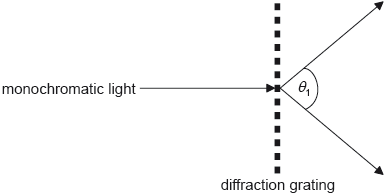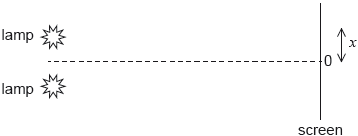DP Physics Questionbank

9.3 – Interference
Description
Nature of science:
Curiosity: Observed patterns of iridescence in animals, such as the shimmer of peacock feathers, led scientists to develop the theory of thin film interference. (1.5)
Serendipity: The first laboratory production of thin films was accidental. (1.5)
Understandings:
- Young’s double-slit experiment
- Modulation of two-slit interference pattern by one-slit diffraction effect
- Multiple slit and diffraction grating interference patterns
- Thin film interference
Applications and skills:
- Qualitatively describing two-slit interference patterns, including modulation by one-slit diffraction effect
- Investigating Young’s double-slit experimentally
- Sketching and interpreting intensity graphs of double-slit interference patterns
- Solving problems involving the diffraction grating equation
- Describing conditions necessary for constructive and destructive interference from thin films, including phase change at interface and effect of refractive index
- Solving problems involving interference from thin films
Guidance:
- Students should be introduced to interference patterns from a variety of coherent sources such as (but not limited to) electromagnetic waves, sound and simulated demonstrations
- Diffraction grating patterns are restricted to those formed at normal incidence
- The treatment of thin film interference is confined to parallel-sided films at normal incidence
- The constructive interference and destructive interference formulae listed below and in the data booklet apply to specific cases of phase changes at interfaces and are not generally true
Data booklet reference:
Theory of knowledge:
- Most two-slit interference descriptions can be made without reference to the one-slit modulation effect. To what level can scientists ignore parts of a model for simplicity and clarity?
Utilization:
- Compact discs are a commercial example of the use of diffraction gratings
- Thin films are used to produce anti-reflection coatings
Aims:
- Aim 4: two scientific concepts (diffraction and interference) come together in this sub-topic, allowing students to analyse and synthesize a wider range of scientific information
- Aim 6: experiments could include (but are not limited to): observing the use of diffraction gratings in spectroscopes; analysis of thin soap films; sound wave and microwave interference pattern analysis
- Aim 9: the ray approach to the description of thin film interference is only an approximation. Students should recognize the limitations of such a visualization
Directly related questions
- 16N.1.HL.TZ0.27: Monochromatic light is incident on a double slit. Both slits have a finite width. The light then...
-
16N.1.HL.TZ0.28:
Light of wavelength λ is incident normally on a diffraction grating that has a slit separation of . What is the greatest number of maxima that can be observed using this arrangement?
A. 4
B. 6
C. 7
D. 9 - 17M.1.HL.TZ1.27: For fringes to be observed in a double-slit interference experiment, the slits must emit waves...
- 17M.1.HL.TZ2.27: Blue light is incident on two narrow slits. Constructive interference takes place along the lines...
-
17M.2.HL.TZ2.4c.i:
Determine the width of one of the slits.
- 17M.2.HL.TZ2.4c.ii: Suggest the variation in the output voltage from the light sensor that will be observed as the...
- 20N.1.HL.TZ0.29: White light is incident normally on separate diffraction gratings X and Y. Y has a greater number...
- 17N.1.HL.TZ0.28: Monochromatic light is incident on two identical slits to produce an interference pattern on a...
-
17N.2.HL.TZ0.6b.i:
State and explain the differences between the pattern on the screen due to the grating and the pattern due to the double slit.
-
17N.1.HL.TZ0.29:
A transparent liquid forms a parallel-sided thin film in air. The diagram shows a ray I incident on the upper air–film boundary at normal incidence (the rays are shown at an angle to the normal for clarity).
Reflections from the top and bottom surfaces of the film result in three rays J, K and L. Which of the rays has undergone a phase change of rad?
A. J only
B. J and L only
C. J and K only
D. J, K and L
-
17N.2.HL.TZ0.6a.i:
Explain why zero intensity is observed at position A.
-
17N.2.HL.TZ0.6a.ii:
The distance from the centre of the pattern to A is 4.1 x 10–2 m. The distance from the screen to the slits is 7.0 m.
Calculate the width of each slit.
-
21M.2.HL.TZ1.6b:
Explain the condition for w that eliminates reflection for a particular light wavelength in air .
- 21M.2.HL.TZ1.6c.i: State the Rayleigh criterion for resolution.
-
21M.2.HL.TZ1.6a:
State the phase change when a ray is reflected at B.
- 21M.2.HL.TZ2.8c.ii: increasing the distance between the diffraction grating and the screen.
- 21M.2.HL.TZ2.8a.i: State the phase difference between the waves at V and Y.
- 21M.2.HL.TZ2.8a.ii: State, in terms of λ, the path length between points X and Z.
-
21M.2.HL.TZ2.8a.iii:
The separation of adjacent slits is d. Show that for the second-order diffraction maximum .
- 21M.2.HL.TZ2.8c.i: using a light source with a smaller wavelength.
-
21M.2.HL.TZ2.8b:
Monochromatic light of wavelength 633 nm is normally incident on a diffraction grating. The diffraction maxima incident on a screen are detected and their angle θ to the central beam is determined. The graph shows the variation of sinθ with the order n of the maximum. The central order corresponds to n = 0.
Determine a mean value for the number of slits per millimetre of the grating.
- 18M.1.HL.TZ1.28: Monochromatic light is incident on 4 rectangular, parallel slits. The first principal maximum is...
-
18M.1.HL.TZ1.27:
Monochromatic light of wavelength λ in air is incident normally on a thin film of refractive index n. The film is surrounded by air. The intensity of the reflected light is a minimum. What is a possible thickness of the film?
A.
B.
C.
D.
-
18M.2.HL.TZ1.3b.i:
Calculate the angular separation between the central peak and the missing peak in the double-slit interference intensity pattern. State your answer to an appropriate number of significant figures.
-
18M.2.HL.TZ1.3b.ii:
Deduce, in mm, the width of one slit.
-
18M.1.HL.TZ2.26:
A beam of monochromatic light is incident on a diffraction grating of N lines per unit length. The angle between the first orders is θ1.

What is the wavelength of the light?
A.
B. N sin θ1
C. N sin
D.
-
18M.2.HL.TZ2.5c:
The slit separation is increased. Outline one change observed on the screen.
-
18M.2.HL.TZ2.5a:
Monochromatic light from two identical lamps arrives on a screen.

The intensity of light on the screen from each lamp separately is I0.
On the axes, sketch a graph to show the variation with distance x on the screen of the intensity I of light on the screen.
-
18M.2.HL.TZ2.5b:
Monochromatic light from a single source is incident on two thin, parallel slits.

The following data are available.
The intensity I of light at the screen from each slit separately is I0. Sketch, on the axes, a graph to show the variation with distance x on the screen of the intensity of light on the screen for this arrangement.
-
21N.1.HL.TZ0.28:
Monochromatic light of wavelength in air is incident normally on a thin liquid film of refractive index that is suspended in air. The rays are shown at an angle to the normal for clarity.
What is the minimum thickness of the film so that the reflected light undergoes constructive interference?
A.B.
C.
D.
- 21N.2.HL.TZ0.8d.ii: State what will happen to the width of the primary maxima.
- 21N.2.HL.TZ0.8d.i: State what will happen to the angular position of the primary maxima.
- 21N.2.HL.TZ0.8d.iii: State what will happen to the intensity of the secondary maxima.
- 18N.2.HL.TZ0.5b.ii: Calculate the angle between the first-order line of the red light in the hydrogen spectrum and...
-
18N.1.HL.TZ0.28:
A beam of monochromatic light is incident normally on a diffraction grating. The grating spacing is d. The angles between the different orders are shown on the diagram.
What is the expression for the wavelength of light used?
A.
B.
C. d sin α
D. d sin β
- 18N.1.HL.TZ0.27: The graph shows the variation with diffraction angle of the intensity of light when monochromatic...
- 18N.2.HL.TZ0.5b.iii: The light source is changed so that white light is incident on the diffraction grating. Outline...
-
22M.1.HL.TZ2.30:
In two different experiments, white light is passed through a single slit and then is either refracted through a prism or diffracted with a diffraction grating. The prism produces a band of colours from M to N. The diffraction grating produces a first order spectrum P to Q.
What are the colours observed at M and P?
-
19M.2.HL.TZ2.3ei:
Calculate the frequency heard by the observer.
- 19M.2.HL.TZ2.8a: Deduce, in W m-2, the intensity at M.
- 19M.2.HL.TZ2.8ci: Suggest why, after this change, the intensity at P will be less than that at M.
-
19M.1.HL.TZ1.31:
A transparent liquid film of refractive index 1.5 coats the outside of a glass lens of higher refractive index. The liquid film is used to eliminate reflection from the lens at wavelength λ in air.
What is the minimum thickness of the liquid film coating and the phase change at the liquid–glass interface?
- 19M.1.HL.TZ1.29: In a Young’s double-slit experiment, the distance between fringes is too small to be...
-
19N.1.HL.TZ0.28:
Light of wavelength λ is normally incident on a diffraction grating of spacing 3λ. What is the angle between the two second-order maxima?
A.
B.
C.
D. >90° so no second orders appear
-
19N.2.HL.TZ0.10b(ii):
calculate the smallest value of d that will result in destructive interference between ray X and ray Y.
- 19N.2.HL.TZ0.10b(i): state, in terms of d, the path difference between the reflected rays X and Y.
-
19N.2.HL.TZ0.10a:
Predict whether reflected ray X undergoes a phase change.
- 19N.2.HL.TZ0.10b(iii): discuss a practical advantage of this arrangement.
